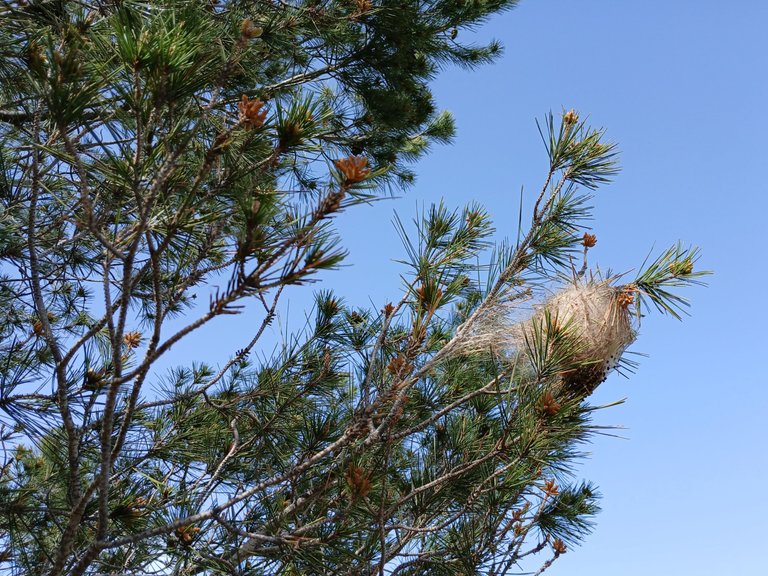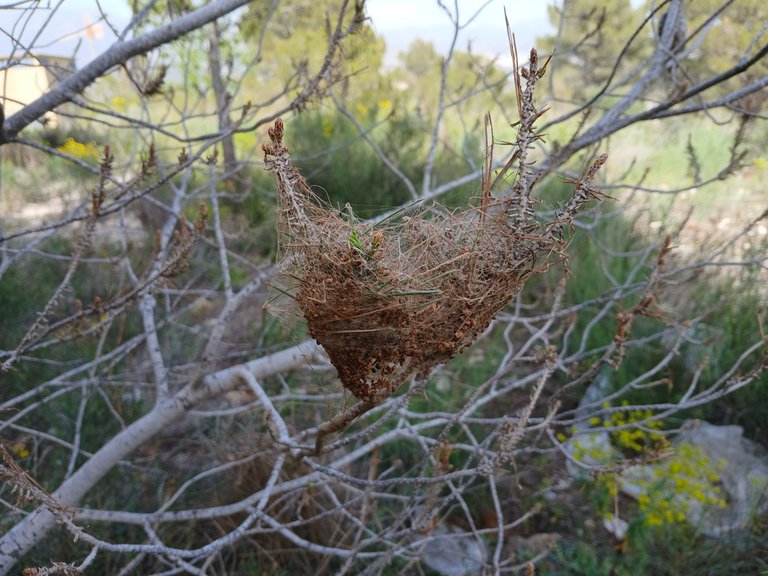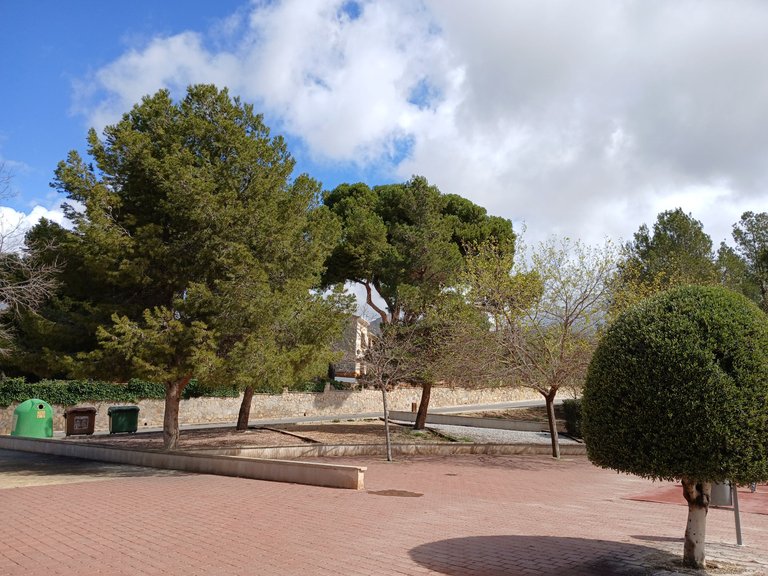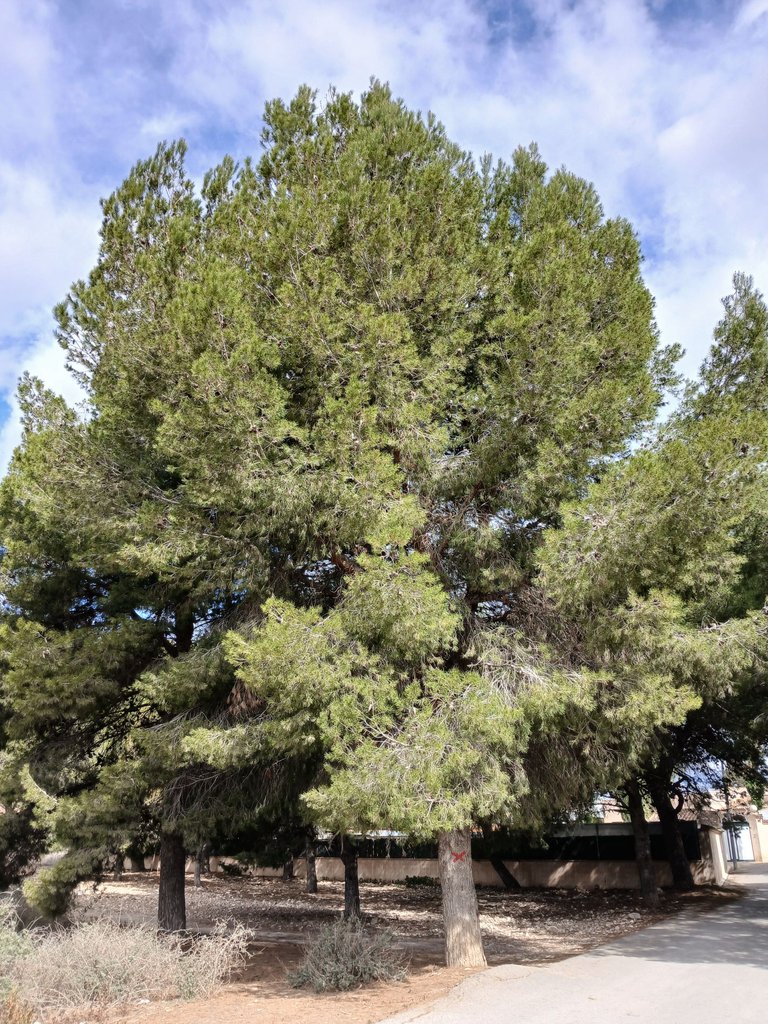
Spain has always been a paradise for those who love good food, outdoor activities, history, and art, but also the warmth that the places near the Mediterranean Sea provide during the winter months. Spring is also pleasant there, for strolls along the seashore or through the coniferous forests. Are you up for it? Good, I would gladly join you. But be careful, there are always things you should know or learn more about because you might touch something that would be better avoided.
I don't want to scare you, but I do want to warn you about some dangers you can find around and how to avoid them. Something that was also new to me when I saw it for the first time, and I imagine it could be just as surprising for others who would visit this part of the peninsula. We talk here about the little, white nests that you can see on the branches of the pine trees. The nests of the pine processionary (Thaumetopoea pityocampa).

They are part of nature, of the ecosystem but due to some changes in the landscapes, we can find them now not just in the forests but in the urban areas where these trees are common. Did they come to the cities to live with us... or, did we actually enter their space so now it is us who live in their territory? Probably the latter, but these caterpillars are not bothered with these things. They live their life cycles as usual, with or without humans. They have always had the capability to protect themselves from predators in a way that now happens that we can also feel on our skin, even though we don't want to harm them.
Yes, you can feel it in your skin, literally, as when you get into contact with the pine processionary be sure to be close to a healthcare centre if you are prone to allergies. You would need an antihistamine injection, the sooner the better. You should also protect your pets, as in dogs the contact with these caterpillars can provoke the worst.

This is already an empty nest, the caterpillars left it and made their procession. (from here their name, as they walk out from the nest in a procession). That is when the contact with them is dangerous. When they move, the tiny, microscopic hairs act like harpoons full of urticating protein, thaumetopoein. You don't even have to touch the caterpillars, it is enough to be close to them to get some of those hairs inhaled from the air or from the surface where they passed.

Around a week ago I saw how a reaction can be nasty and quick. One of my adult students came to his piano lesson and mentioned that he just cleaned up with a long-handled broom these caterpillars from his yard. While we were talking, red spots were appearing on his face, hands, and neck and he said he felt his tongue started to swell. It was incredible to witness how this allergic reaction became so heavy just in a few minutes. We concluded that it was better for him to seek immediate medical attention. He got an injection and informed me later that the allergic reaction faded away during the afternoon. He is fine now.

Now the pine processionary caterpillars already left the nests and hopefully buried themselves into the soils to form the cocoons. They are not dangerous anymore there. It is just the hairs of the caterpillar that can make trouble for pets or provoke eye and skin irritations in humans.

The pine processionary can be also found in other countries of southern Europe, not just in Spain, but I think the mild, warm winters are those that they like the most. I hope this was not a thing to scare anyone, but just to warn about these little hairy creatures - if you happen to be in this area in February or March when it is their time to leave the nest, please just avoid touching their shelter or them, and don't leave your children and pets go close to these caterpillars when they walk in their processions.

español 🇪🇸

España siempre ha sido un paraíso para los amantes de la buena comida, las actividades al aire libre, la historia y el arte, pero también para los amantes de la calidez que brindan los lugares cercanos al mar Mediterráneo durante los meses de invierno. La primavera también es agradable allí, para pasear por la orilla del mar o por los bosques de coníferas. ¿Te animas? Bien, me uniría con gusto. Pero ten cuidado, siempre hay cosas que debes saber porque podrías tocar algo que es mejor evitar.
No quiero asustarte, pero sí quiero advertirte sobre algunos peligros que puedes encontrar y cómo evitarlos. Algo que también fue nuevo para mí cuando lo vi por primera vez, y me imagino que podría ser igual de sorprendente para quienes visiten esta parte de la península. Hablamos aquí de los pequeños nidos blancos que se pueden ver en las ramas de los pinos. Los nidos de la oruga procesionaria (Thaumetopoea pityocampa).

Son parte de la naturaleza, del ecosistema, pero debido a cambios en el paisaje, ahora podemos encontrarlos no solo en los bosques, sino también en las zonas urbanas donde estos árboles son comunes. ¿Vinieron a las ciudades para vivir con nosotros... o, entramos en su espacio y ahora somos nosotros quienes vivimos en su territorio? Probablemente esto último, pero a estas orugas no les preocupan estas cosas. Viven sus ciclos de vida como siempre, con o sin humanos. Siempre han tenido la capacidad de protegerse de los depredadores de una forma que ahora también podemos sentir en nuestra piel, aunque no queramos hacerles daño.
Sí, se siente en la piel, literalmente. Cuando entras en contacto con la oruga procesionaria asegúrate de estar cerca de un centro de salud si eres propenso a las alergias. Necesitarías una inyección de antihistamínico, cuanto antes mejor. También debes proteger a tus mascotas, ya que en los perros el contacto con estas orugas puede provocarles las peores consecuencias.

Este nido ya está vacío; las orugas lo abandonaron y emprendieron su procesión (de ahí su nombre, ya que salen del nido en procesión). Es entonces cuando el contacto con ellas se vuelve peligroso. Al moverse, sus pelos microscópicos actúan como arpones llenos de una proteína urticante. Ni siquiera es necesario tocarlas; basta con estar cerca para inhalar algunos de esos pelos del aire o de la superficie por donde pasaron.

Hace aproximadamente una semana, vi cómo una reacción puede ser desagradable y rápida. Uno de mis alumnos adultos vino a su clase de piano y comentó que acababa de limpiar con una escoba de mango largo unas orugas de su jardín. Mientras hablábamos, le aparecieron manchas rojas en la cara, las manos y el cuello, y dijo que sintió que se le hinchaba la lengua. Fue increíble presenciar cómo esta reacción alérgica se volvió tan grave en tan solo unos minutos. Concluimos que era mejor que buscara atención médica inmediata. Más tarde me informó que la reacción alérgica desapareció durante la trade después de recibir una inyección. Ahora está bien.

Ahora, las orugas procesionarias del pino ya han abandonado sus nidos y, con suerte, se han enterrado en la tierra para formar los capullos. Ya no representan peligro allí. Son solo los pelos de la oruga los que pueden causar problemas a las mascotas o provocar irritaciones en los ojos y la piel de los humanos.

La procesionaria también se encuentra en otros países del sur de Europa, no solo en España, pero creo que los inviernos suaves y cálidos son los que más les gustan. Espero que esto no haya sido para asustar a nadie, sino simplemente para advertir sobre estas pequeñas criaturas peludas: si te encuentras por aquí en febrero o marzo, cuando es el momento de abandonar el nido, por favor, evita tocar su refugio o a ellas, y no dejes que tus hijos o mascotas se acerquen a estas orugas cuando paseen en sus procesiones.

